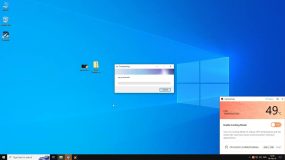UEFI is the modern replacement for the older BIOS system, now widely used by brands like Dell, Acer, and HP in their computers. Sometimes, Windows updates fail due to a UEFI error, showing a message like:
- “Windows 10/11 couldn’t be installed.”
- “Windows can’t be installed because this PC has an unsupported disk layout for UEFI firmware.”
Encountering a UEFI error while updating Windows 10 or 11 can be frustrating. This guide provides step-by-step solutions to resolve the issue and get your system running smoothly.

Read about common Windows Errors:
UNEXPECTED KERNEL MODE TRAP Error
WHEA_UNCORRECTABLE_ERROR error
How to Fix UEFI Error to Update Windows
The “unsupported disk layout for UEFI firmware” error means your hard drive’s partition structure isn’t compatible with the Windows 10 or 11 version you’re trying to upgrade to.
The way out is to create a Microsoft Reserved Partition, used for the UEFI/GPT disks. As technical as that sounds, these steps will surely get you through the problem and on with the update of your Windows.
#1: Run Command Prompt as Administrator
Open the Command Prompt as an administrator to troubleshoot the UEFI error.
- Press the Win + X and choose among Command Prompt (Admin) and Windows Terminal (Admin).
- If User Account Control pops up, click Yes to continue.
Having opened the Command Prompt, now is the time to proceed step by step.
#2: Run Diskpart.exe. Afterwards, Create the MSR Partition
If your system lacks an MSR (Microsoft Reserved) partition, it can trigger UEFI-related issues.
- In Command Prompt, type
diskpartand press Enter. - Type list disk to view connected drives.
- Identify your primary drive (usually Disk 0) and type select disk 0.
- Type list partition to display partitions.
- If the MSR partition is missing, type these commands one by one:
- create partition msr size=128
- exit
This action restores the necessary partition layout for UEFI firmware.
#3: Have Another Try at a Windows 10/11 Upgrade
After repairing the partition structure, try upgrading to Windows:
- Open Settings > Update & Security > Windows Update and click Check for updates.
- Alternatively, download and run the Media Creation Tool from Microsoft’s website for a manual upgrade.
- Follow the instructions to complete the update.
How to Perform a Fresh Install to Fix UEFI Error
In case others don’t work, one may need to do a fresh install:
- Create a bootable USB with the Windows Media Creation Tool.
- Restart your computer. Access the UEFI firmware settings: Press F2, F12, or DEL during boot.
- Set the USB drive as your first boot device.
- Boot from the USB and follow installation prompts. Delete all partitions on the drive and let Windows create a UEFI-compatible layout.
This fresh installation should eliminate UEFI errors.
FAQs
1. What does UEFI firmware settings mean?
UEFI firmware settings allow you to manage low-level system operations like boot order and hardware initialization.
2. Why does unsupported disk layout for UEFI firmware occur?
This happens when the partition structure doesn’t meet UEFI requirements, such as missing an MSR or EFI partition.
3. Are the UEFI errors fixable without reinstalling Windows?
Yes, many times running Diskpart for adjusting the partitions fixes this.
4. Is there any tool that can avoid such errors?
Tools like Outbyte PC Repair can optimize your system and minimize update-related issues.
5. Do I have to back up my data before reinstalling?
Yes, always back up important files to avoid loss of data during a fresh installation.






